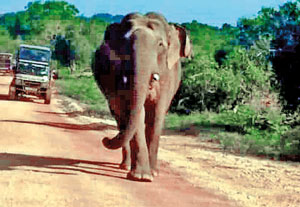News
No let up in deaths of elephants and humans
View(s):
By Kasun Warakapitiya
Last year, there were 433 deaths of elephants and 145 humans. The deaths of elephants was the highest in recent years, with the previous high being 405 in 2019.
A senior Wildlife Conservation Department (DWC) official said elephant and human deaths had increased in the past 20 years. The highest number of deaths were last year.
The official said encroachment of land, development activities, and cultivation had deprived elephants of feeding areas.
Tissamaharama resident Kolamba Arachchige Princy Surendra cited the clearing of land in forested areas as a main reason that elephants enter villages.

The National Action Plan for the Mitigation of Human Elephant Conflict has not been implemented even though it was prepared two years back.
“Around 50 acres in Gal Ara area was cleared in November, even though this is on the boundary of the Yala National Park, the area cleared is where elephants feed,’’ he said. He said politicians allow businessmen to clear wildlife areas, and even allow people to settle targeting votes at elections. As a result of encroachment elephants come into human habitations in search of food and water.
Environmentalists said the Department had failed so far.
The National Action Plan for the Mitigation of Human Elephant Conflict has not been implemented even though it was prepared two years back.
The convener of the Biodiversity Conservation Research Circle, Supun Lahiru Prakash, alleged that senior DWC officials were misleading stakeholders and the Minister in Charge of Wildlife and Forest Resources Conservation Mahinda Amaraweera on the national human-elephant conflict mitigation plan.
He said that Mr Amaraweera had said during the budget debate that 16 elephant corridors would be created to reduce the human-elephant conflict by half. 
“As far as we know, this 16 elephant corridor proposal came up in 2014 and it was planned to network national parks and some elephant conservation areas confining elephants into them. They tried this in the past six decades and completely failed,’’ he said.
Mr Prakash said the DWC had at first declared corridors when trying to implement the previously ineffective strategy of confining elephants to national parks.
He said the conservation of elephant home ranges outside the protected areas should be mandatory and urged that the national action plan be implemented at least now.
Responding to comments of environmentalists, DWC Director General Chanadana Sooriyabandara said that the human-elephant conflict occurred as a result of land use patterns and population density of elephants.
Mr Sooriyabandra said environmentalist should study the breakdown of elephant deaths, not the total.
“Only 150 to 200 deaths occur due to direct human-elephant conflict. We also included elephant carcasses found inside wildlife parks. Most are putrefied carcasses believed to be of animals that died naturally and of still-born calves,” he said.
However, environmentalist’s counter claim that more than 60 percent of elephant deaths occurred due to electrocution, gunshots, and ‘Hakka Patas’, or ‘jaw bombs’.
Mr Sooriyabandara admitted that the DWC faced difficulties in 2022, but worked according to the human-elephant conflict mitigation action plan. He denied the allegations of environmentalists.
Wildlife and Forest Resources Conservation Minister Mahinda Aamaraweera told the Sunday Times, three elephant corridors would be opened this year.
“We will even have to acquire some Mahaweli Authority lands to open up these elephant corridors. The DWC experts and senior officials pointed out that this would greatly reduce the human elephant conflict.”
He said that while the comments of environmentalists might be true, the Government officials’ recommendations also should be carried out. “Environmentalist submit their proposals to the ministry and we can also consider their requests.”
The best way to say that you found the home of your dreams is by finding it on Hitad.lk. We have listings for apartments for sale or rent in Sri Lanka, no matter what locale you're looking for! Whether you live in Colombo, Galle, Kandy, Matara, Jaffna and more - we've got them all!

